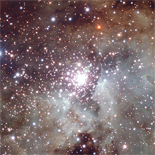Astronomy 352K - Fall 2010
STELLAR ASTRONOMY
MWF 9-10 · RLM 15.216B · Unique No. 47725

NGC 3603 (ESO)
Professor
RLM 17.206 · TBA · (512) 471-1349 · email
Courses - Fall '10 | Course Website
Overlap with other courses? There is a small amount of overlap between AST 352K and AST 358 (Galaxies and the Universe), AST 353 (Astrophysics), and AST 352L (Positional, Kinematical, and Dynamical Astronomy). We will try to avoid excessive redundancy, but that is inevitable in some subject areas, since not all members of the present class will have taken these other courses.
Textbook? For the first time in my recent teaching of this course, we will have a textbook: Francis LeBlanc's An Introduction to Stellar Astrophysics. This book is so new that we have had struggles in getting copies. The University Co-op says that it will come in on August 28. Until then, the author and publisher have kindly given us access to pdf files of the first two chapters. I have put these files on the class web site in our password-restricted area. The book covers material appropriate to both this course and the AST 353 course that includes discussion of stellar interiors and nuclear energy generation. This is a nice single source for basic information about stars, and I like its presumption that many readers will have had no prior introduction to astronomy in any detail.
Class notes? I also am posting copies of my notes on the class web site. I have alternated teaching this course with Prof. Harriet Dinerstein, and between us we have pretty much settled on the topics and presentation order that we like. Harriet made a major upgrade in the class notes a few years ago, and the current version has a lot of her ideas in it.
Independent topic report? Students generally benefit from the experience of researching a specific topic in some depth. To accomplish this here, about mid semester you will divided into groups and asked to give a short group presentation on a topic that deals with some interesting aspect of stellar astronomy. The presentations will occur the last 2-3 class days of the semester. They will consist of an oral exposition of a poster or slide set on the subject that you have prepared for the occasion. Your grade will be determined from a combination of astronomical content, presentation style and overall effort. The members of the group will work together to decide how to divide up the larger topic into individual sections. Groups that work together well and give uniformly high-quality presentations will get "bonus" points added to their grade, giving students an incentive to help each other.
My bias in this course? I regard AST 352K as a vital link between the basic, often elegant physics and mathematics that you have ingested at UT for the past two-three years, and the real, often messy world of astronomical research. Astrophysics combines elements from all areas of physics to offer coherent theoretical models for how the solar system, galaxy, and universe are constructed and how they have and will evolve. If you are looking for that in this course, forget it. Theoretical astrophysics cannot really derive rational models for an object without appealing to observational astronomy. I am not an astrophysicist as the term is sometimes meant (that is, I am not a theorist). I am an observational astronomer, and proud of it. And observational astronomy is what you will find covered in this course. Not how is the universe constructed, but how does one practically assemble the basic data about particular astronomical objects (stars) that can be gainfully used in constructing the story of the universe?
So forget cookbook problems? Not entirely, but we will deal as much as possible with real data from the literature that have been obtained at various astronomical facilities over the past decades, and which now are readily available for study. Many of the homework problems will encourage you to seek data from basic astronomical catalogs. These sources can be found on web sites and in our Peridier Library, to which we intend to introduce you if you have not already seen it. However, a serious word needs to be given here. The Peridier Library is NOT part of the general UT library system, but is instead a part of the department and observatory research facility. It is available to help you by providing materials for this course. It is intended solely for the use of our faculty, staff, and research students. We invite you to begin integrating into our program with privileges to the Peridier Library. Please use this library moderately, quietly and with respect for others. Think of your use of the Peridier Library as a guest membership at a club, and please do not abuse it or overstay your welcome.